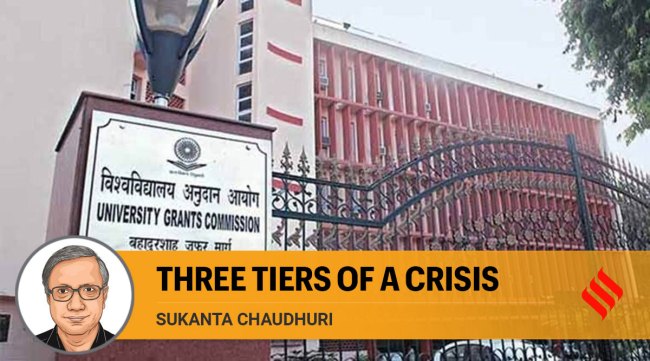Opinion UGC proposal for foreign universities in India: Three tiers of a crisis
Public universities are in crisis and private universities out of reach for most. Entry of foreign universities will exacerbate inequalities.
 The University Grants Commission has released draft regulations to allow foreign universities to enter India. (File Photo)
The University Grants Commission has released draft regulations to allow foreign universities to enter India. (File Photo) Three swimmers enter a competition. One is allowed free use of all four limbs. The second has hands tied, and the third, both hands and feet.
That could be an apt allegory of Indian higher education if, following the UGC’s latest proposal, foreign universities freely set up campuses in India. “Freely” means just that. They can appoint their own staff, Indian and foreign, on their own terms, and devise their own courses. They can determine admission procedure and fee structure. The only restrictions are that they cannot offer online courses (for how long, one wonders), endanger India’s national interest, or jeopardise the standards of education in India. The last would indeed be an ironic outcome. If India’s national interest is as fiercely monitored on these campuses as on desi ones, would they accept such a regime?
Why should our vishwaguru nation bend over backwards to import instruction from abroad? No doubt it exemplifies the noble principle of atithi devo bhava. But our traditions honour home-grown gurus as well. How are they faring?
Some of those gurus subsist on students’ dakshina, others on patronage. The first lot, private universities, enjoy many of the above freedoms but not others. They are vulnerable to political pressures. If private universities have their hands tied, public universities are bound hand and foot. They cannot appoint foreign faculty. Their curricula are straitjacketed by UGC models. Research funds are increasingly tied to set fields and topics — a trend likely to swell under the new National Education Policy. Government grants are plummeting, even as the freedom to seek funds elsewhere is curtailed.
Some concerns about the entry of foreign universities were powerfully voiced by Pratap Bhanu Mehta (‘The Gimmicks Commission’, IE, January 9). I need not repeat them. There are enough other issues. Universities allowed entry must rank among the world’s top 500, but other institutions have to be merely “reputed” back home. How would that reputation be measured?
Again, if these universities followed their current curricular patterns, how would they mesh with each other, or with Indian norms? Britain chiefly has three-year undergraduate programmes, the US has four-year ones. Master’s courses come in all shapes and sizes, as does the build-up to doctoral research. One wonders how far the UGC appreciates the intellectual implications of its proposal. Its chairperson instances urban design and fashion design as the kind of “diverse” courses desired. Where do fundamental studies feature in this concept? If they do not, what will we gain from the world’s leading institutes?
But the really troubling questions concern the context of tertiary education. Currently, India has two types of tertiary institutions, public and private. Public universities have traditionally charged very low fees with no relation to costs. Even the poorest student could enter university, assuming she cracked our inequitable school system. The chief source of funds was government grants.
The Union government is now aggressively slashing grants and pressing for a major hike in fees, at times beyond the means of even middle-class students. This has caused unrest even in the IITs, where students are reconciled to high fees — where, the government still provides substantial funds. Far stronger protests (as currently at Allahabad University) have come from students studying general courses at central universities, where faculty appointments and grants have been grossly curtailed. Courses and standards are in jeopardy, while many students are dropping out from financial constraints. Universities under state governments face the same trauma in heightened form.
The crisis of public universities has brought into being a new generation of academically ambitious private universities. They are few in number, and likely to remain so. Not many students can spend in six or seven figures for an “unremunerative” degree in basic science or humanities. Some private universities have a laudable but inevitably limited programme of scholarships. Most crucially, few indigent students can negotiate the state school system to qualify for admission in the first place. At the same time, there is a ceiling to the income even from such high fees. Educational philanthropy in India is nascent compared to, say, in the US. Hence private universities, too, face financial and educational challenges — for both the institution and the student.
Yet within their purview, they might have achieved stability over time. That prospect will diminish with the entry of foreign universities. The most affluent and ambitious students will shift to the latter, depriving home-grown private universities of the cream of their limited intake. Yet that cream might curdle in its new vessel. Those students might save on the expenses of living abroad, but it is simply unreal to suggest that their experience can approach that of the parent campus.
Many university systems in the world are scarred by divisions and exclusions. The US is a prominent instance. But if the current proposal goes through, India will have spawned a three-tier system uniquely divided by inequalities of class and wealth. The greater part of India’s youth would be roundly deprived of quality higher education — the nation will lose out on the greater part of its human resources.
The success of an educational community depends disproportionately on the participation of the already-educated elite. If they shift patronage to a more exclusive class of institutions, the tremors destabilise the tiers below. Yet, even the upper tiers will suffer an institutional deficit, preventing us from matching the great educational ecosystems of the world.
Despite its many faults, the upper end of our public university system had gone a long way in setting up a comparable ecosystem, organically adapted to Indian conditions. Instead of reforming its defects, we have thrown out the baby with the bathwater. Is there still time to pull it out by the toe before it disappears down the drain?
The writer is professor emeritus, department of English, Jadavpur University




